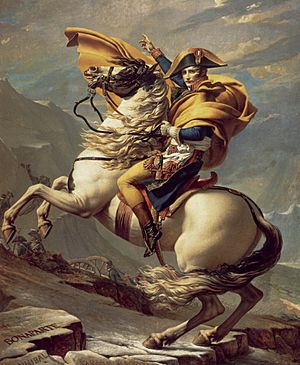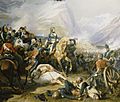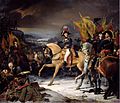French Revolutionary Wars facts for kids

The French Revolutionary Wars were a series of major conflicts. They took place between 1792 and 1802. These wars involved the new Revolutionary government of France. They fought against many other European countries.
These wars were special because of the strong spirit of the French Revolution. Also, France used new ways of fighting. The French armies defeated several groups of opposing countries, called coalitions. France gained control over areas like the Low Countries (modern-day Belgium and Netherlands), Italy, and the Rhineland (parts of Germany).
A huge number of soldiers fought in these wars. This was because France started using "mass conscription." This meant that many ordinary citizens were drafted into the army. The wars are usually split into two main parts: the First Coalition (1792 to 1797) and the Second Coalition (1798 to 1801). However, France was constantly at war with Great Britain from 1793 until 1802. The fighting stopped for a short time with the Treaty of Amiens in 1802. But soon after, new conflicts began, known as the Napoleonic Wars.
Contents
Why the Wars Started
The French Revolutionary Wars began because of big changes in France. In 1789, the French Revolution started. The people overthrew their king and created a new government. Other European kings and queens worried that similar revolutions might happen in their own countries. They also wanted to restore the French monarchy.
Early Conflicts and French Victories
In 1792, Austria and Prussia formed an alliance. They declared war on France. They hoped to quickly defeat the new French government. However, the French armies fought with great passion. They were defending their new republic.
The Battle of Valmy
One important early battle was the Battle of Valmy in September 1792. The French army, though less experienced, managed to stop the Prussian invasion. This victory was a huge boost for French morale. It showed that the new French Republic could defend itself.
French Expansion
After Valmy, France began to push back. They conquered parts of the Austrian Netherlands (modern-day Belgium). They also moved into the Rhineland. The French believed they were spreading the ideas of liberty and equality across Europe.
The First Coalition (1792–1797)
Many European countries formed a "coalition" against France. This group included Great Britain, Austria, Prussia, Spain, and others. They were worried about France's growing power and revolutionary ideas.
Key Campaigns and Battles
The French army, led by talented generals, fought many battles. They often used new tactics. These tactics helped them win against larger, more traditional armies.
Napoleon's Rise in Italy
A young general named Napoleon Bonaparte became famous during this time. In 1796, he led the French army in Italy. He won many impressive victories against the Austrians. Battles like Battle of Lodi and Battle of Rivoli showed his brilliant military skills. Napoleon's success in Italy forced Austria to sign a peace treaty. This ended the War of the First Coalition.
The Second Coalition (1798–1801)
After a short period of peace, a new group of countries formed against France. This Second Coalition included Great Britain, Austria, and Russia. They wanted to stop France's influence in Europe.
Napoleon in Egypt
In 1798, Napoleon led a French army to Egypt. He hoped to disrupt British trade routes to India. While he won battles on land, like the Battle of the Pyramids, the British navy destroyed the French fleet at the Battle of the Nile. This left Napoleon's army stranded.
Fighting in Europe
Meanwhile, fighting continued in Europe. The French faced strong resistance from the Austrians and Russians. Russian General Alexander Suvorov achieved some victories in Italy. However, the French managed to regain control.
The Battle of Marengo
Napoleon returned from Egypt in 1799. He took control of the French government. In 1800, he led his army to a decisive victory at the Battle of Marengo in Italy. This win helped secure France's position.
The Battle of Hohenlinden
Another important French victory was the Battle of Hohenlinden in December 1800. This battle, fought in Bavaria, was a major defeat for Austria. It forced them to sign another peace treaty with France.
End of the Wars
By 1801, most of France's enemies had made peace. Only Great Britain remained at war. Finally, in 1802, France and Great Britain signed the Treaty of Amiens. This officially ended the French Revolutionary Wars. However, this peace was short-lived. The conflicts soon started again, leading to the long and famous Napoleonic Wars.
Images for kids
-
General Jourdan at the battle of Fleurus, 26 June 1794
-
Armée des Émigrés at the Battle of Quiberon
-
General Bonaparte and his troops crossing the bridge of Arcole
-
Napoleon Bonaparte defeats the Austrians at the Battle of Lodi
-
Napoleon Bonaparte at the Battle of Rivoli
-
In July 1798, French forces under Napoleon annihilated an Egyptian army at the Battle of the Pyramids. The victory facilitated the conquest of Egypt and remains one of the most important battles of the era.
-
Battle of the Nile, August 1798. The British fleet bears down on the French line.
-
The Battle of Abukir in 1799
-
The Battle of Mount Tabor against the Ottomans
-
Russian General Alexander Suvorov crossing the St. Gotthard Pass during the Italian and Swiss expedition in 1799
-
General Moreau at the Battle of Hohenlinden, a decisive French victory in Bavaria which precipitated the end of the Revolutionary Wars
-
The armies of the Revolution at Jemappes in 1792. With chaos internally and enemies on the borders, the French were in a period of uncertainty during the early years of the Revolutionary Wars. By 1797, however, France dominated much of Western Europe, conquering the Rhineland, the Netherlands, and the Italian peninsula while erecting a series of sister republics and puppet states stretching from Spain to the German heartland.
See also
 In Spanish: Guerras revolucionarias francesas para niños
In Spanish: Guerras revolucionarias francesas para niños















